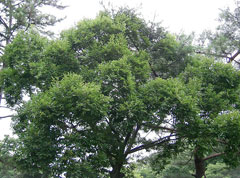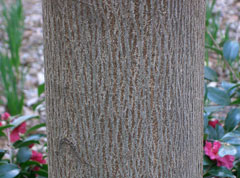 |
|
http://commons.wikimedia.org/wiki/User:KENPEI |
 |
| http://commons.wikimedia.org/wiki/User:KENPEI |
Translate this page:
Summary
Physical Characteristics

 Aphananthe aspera is a deciduous Tree growing to 20 m (65ft 7in).
Aphananthe aspera is a deciduous Tree growing to 20 m (65ft 7in).
See above for USDA hardiness. It is hardy to UK zone 7 and is not frost tender. It is in flower from April to May, and the seeds ripen from September to October. The species is monoecious (individual flowers are either male or female, but both sexes can be found on the same plant).
Suitable for: light (sandy), medium (loamy) and heavy (clay) soils. Suitable pH: mildly acid, neutral and basic (mildly alkaline) soils. It can grow in semi-shade (light woodland) or no shade. It prefers dry or moist soil.
UK Hardiness Map
US Hardiness Map
Synonyms
Celtis muka. Homoioceltis aspera. Prunus aspera.
Plant Habitats
Woodland Garden Canopy;
Edible Uses
Edible Parts: Fruit
Edible Uses:
Fruit[105, 177]. The fruit is about 6 - 8mm in diameter[200].
References More on Edible Uses
Medicinal Uses
Plants For A Future can not take any responsibility for any adverse effects from the use of plants. Always seek advice from a professional before using a plant medicinally.
None known
References More on Medicinal Uses
The Bookshop: Edible Plant Books
Our Latest books on Perennial Plants For Food Forests and Permaculture Gardens in paperback or digital formats.

Edible Tropical Plants
Food Forest Plants for Hotter Conditions: 250+ Plants For Tropical Food Forests & Permaculture Gardens.
More

Edible Temperate Plants
Plants for Your Food Forest: 500 Plants for Temperate Food Forests & Permaculture Gardens.
More

More Books
PFAF have eight books available in paperback and digital formats. Browse the shop for more information.
Shop Now
Other Uses
Fibre Paper Sandpaper Wood
The leaves, gathered in autumn, are used as a sandpaper on wood[46, 61]. The fibre from the bark is used for manufacturing ropes and staple rayon[266]. The wood is fine and strong[266].
Special Uses
References More on Other Uses
Cultivation details
Succeeds in most soils, including dry gravels, but prefers a deep fertile soil[200]. Plants are frost tender when young but they are able to regrow from the base if cut back[11]. A tree growing outdoors at Kew Botanical Gardens has reached a height of 8 metres[11].
References Carbon Farming Information and Carbon Sequestration Information
Temperature Converter
Type a value in the Celsius field to convert the value to Fahrenheit:
Fahrenheit:
The PFAF Bookshop
Plants For A Future have a number of books available in paperback and digital form. Book titles include Edible Plants, Edible Perennials, Edible Trees,Edible Shrubs, Woodland Gardening, and Temperate Food Forest Plants. Our new book is Food Forest Plants For Hotter Conditions (Tropical and Sub-Tropical).
Shop Now
Plant Propagation
Seed - it probably requires 2 - 3 months stratification. It is best to sow the seed as soon as it is ripe in a cold frame, otherwise sow as soon as possible in the year. Remove any pulp from the seed before sowing it[200]. When large enough to handle, prick the seedlings out into individual pots and grow them on in the greenhouse for at least their first winter before planting them out in late spring or early summer, after the last expected frosts.
Other Names
If available other names are mentioned here
Native Range
TEMPERATE ASIA: China (Anhui Sheng, Zhejiang Sheng, Fujian Sheng, Hunan Sheng, Hubei Sheng, Jiangxi Sheng, Jiangsu Sheng, Guangdong Sheng, Guizhou Sheng, Shanxi Sheng, Shandong Sheng, Shaanxi Sheng, Sichuan Sheng, Yunnan Sheng, Guangxi Zhuangzu Zizhiqu), Korea, Japan (Honshu, Kyushu, Shikoku), Taiwan TROPICAL ASIA: Vietnam
Weed Potential
Right plant wrong place. We are currently updating this section.
Please note that a plant may be invasive in one area but may not in your area so it's worth checking.
Conservation Status
IUCN Red List of Threatened Plants Status :

Growth: S = slow M = medium F = fast. Soil: L = light (sandy) M = medium H = heavy (clay). pH: A = acid N = neutral B = basic (alkaline). Shade: F = full shade S = semi-shade N = no shade. Moisture: D = dry M = Moist We = wet Wa = water.
Now available:
Food Forest Plants for Mediterranean Conditions
350+ Perennial Plants For Mediterranean and Drier Food Forests and Permaculture Gardens.
[Paperback and eBook]
This is the third in Plants For A Future's series of plant guides for food forests tailored to
specific climate zones. Following volumes on temperate and tropical ecosystems, this book focuses
on species suited to Mediterranean conditions—regions with hot, dry summers and cool, wet winters,
often facing the added challenge of climate change.
Read More
Expert comment
Author
(Thunb.)Planch.
Botanical References
1158200
Links / References
For a list of references used on this page please go here
Readers comment
| Add a comment |
|
If you have important information about this plant that may help other users please add a comment or link below. Only comments or links that are felt to be directly relevant to a plant will be included. If you think a comment/link or information contained on this page is inaccurate or misleading we would welcome your feedback at [email protected]. If you have questions about a plant please use the Forum on this website as we do not have the resources to answer questions ourselves.
* Please note: the comments by website users are not necessarily those held by PFAF and may give misleading or inaccurate information.
To leave a comment please Register or login here All comments need to be approved so will not appear immediately.
|
Subject : Aphananthe aspera
|
|
|
|